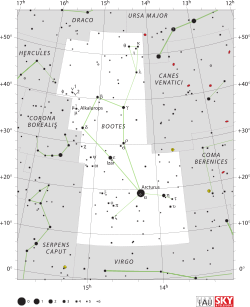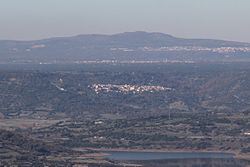타우헤르쿨리데스
Tau Herculids| 타우헤르쿨리데스 | |
|---|---|
| 모체 | 73P/슈와스만-와흐만 |
| 래디언트 | |
| 콘스텔레이션 | 부에테스[1] |
| 우등승 | 13h 56m |
| 점괘 | +28° |
| 특성. | |
| 동안 발생합니다. | 5월 19일 ~ 6월 19일 |
| 피크일자 | 5월31일[1] |
| 속도 | 초속 16km[1] |
| 제니탈 시간당 요금 | 변수(Class III) |
타우 허큘리스자리 TAH #0061은 1930년에 발견되었을 때 별 타우 허큘리스에서 기원한 것으로 보이는 유성우입니다.허큘리스자리 타우의 모혜성은 주기율 5.4년의 슈바슈만-바흐만 3 혜성입니다.이 유성우는 5월 19일부터 6월 19일까지 발생합니다.유성우는 1930년 5월 일본 교토의 콰산 천문대에서 처음 관측되었습니다.타우 헤르쿨루스족의 평균 복사량은 α=236°였고,δ=+41°목성에 의한 운석류의 궤도 섭동으로 인해 2022년 활동은 R.A. = 13:56 (209), Decl.= +28(Bötes 별자리에 있는 Arcturus의 북서쪽).[1]유성들은 상대적으로 느리게 움직여서 대기권 진입 속도가 약 16km/s(36,000mph)에 이릅니다.
1930년 5월 31일,[3] 혜성은 지구에서 약 0.062 AU (930만 km) 떨어진 곳을 지나갔고, 1930년 6월 9일에는 시간당 약 100개의 유성 폭발이 관측되었으며,[4] 이후 1930년 6월 14일에는 근일점 (태양에 가장 가까운 거리)을 지나갔습니다.
2022년 5월 30일부터 31일까지(5월 31일 UT 4:00-5:00), 모혜성 73P의 1995년 분해로 인한 작은 유성우가 발생했습니다.[5][6]이것은 지난 27년 동안 혜성 앞에서 파편들이 이동해 왔어야 했습니다.[7]모혜성은 2022년 8월 25일까지 근일점(태양으로부터 0.97 천문단위)에 69개의 조각을[8] 가지고 있습니다.[9]2022년 5월 30일, 73P/슈와스만-와흐만 혜성은 태양으로부터 1.5 천문단위, 지구로부터 1.4 천문단위 떨어져 있었습니다.[10]다음으로 주목할 만한 타우 헤르쿨루스족의 출현은 2033년과[6] 2049년으로 예상됩니다.[4]
참고문헌
- ^ a b c d Peter Jenniskens (30 May 2022). "Anticipating a meteor outburst: Global CAMS video network detects first 2022 tau Herculids". Meteor News. Retrieved 2022-05-30.
- ^ "Meteor Showers Online". Archived from the original on 18 July 2018.
- ^ "Horizons Batch for 73P [1930] (90000728) Earth approach on 1930-05-31" (r is distance from the Sun and delta is the distance from Earth). JPL Horizons. Retrieved 2022-06-05.
- ^ a b Weigert, P.A.; Brown, P.G.; Vaubaillon, J.; Schijns, H. (2005). "The τ Herculid meteor shower and Comet 73P/Schwassmann-Wachmann 3". Monthly Notices of the Royal Astronomical Society. 361 (2): 638–644. Bibcode:2005MNRAS.361..638W. doi:10.1111/j.1365-2966.2005.09199.x.
- ^ Joe Rao (2022-05-26). "Update on a Possible Outburst of Meteors". Sky & Telescope. Retrieved 2022-05-29.
- ^ a b Robert Lunsford (2022-06-06). "Observed Meteor Outburst of tau-Herculids!". International Meteor Organization. Retrieved 2022-06-07.
- ^ Lee Mohon (2022-05-27). "New meteor shower? How many meteors will I see, really?". NASA. Retrieved 2022-05-29.
- ^ "JPL Small-Body Database Browser: 73P/Schwassmann–Wachmann (69 objects)". Retrieved 2022-05-29.
- ^ "73P/Schwassmann-Wachmann Orbit". Minor Planet Center. Retrieved 2022-05-29.
- ^ "Horizons Batch for 73P (90000733) on 2022-05-30" (r is distance from the Sun and delta is the distance from Earth). JPL Horizons. Retrieved 2022-05-29.
외부 링크
- 글로벌 유성 네트워크 카메라로 본 타우 헤르쿨루스 (2022년 5월 30일 데니스 비다)
- 라디오 유성 관측 (5월 31일 UT 4:00경 정점)
- 키트 피크 망원경 위의 타우 허큘리스 유성들 (5월 30일 2.5시간 이상 누적된 오늘의 천문학 사진)




